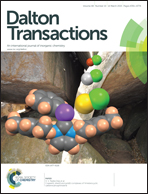Lanthano phosphomolybdate-decorated silica nanoparticles: novel hybrid materials with photochromic properties†
Abstract
Novel photochromic hybrid nanomaterials were prepared through the immobilization of the lacunary Keggin-type phosphomolybdate (TBA4H3[PMo11O39]·xH2O, denoted as PMo11) and sandwich-type lanthano phosphomolybdates (K11[LnIII(PMo11O39)2]·xH2O, denoted as Ln(PMo11)2, where LnIII = Sm, Eu, Gd, Tb and Dy) onto positively-charged functionalized silica nanoparticles. The functionalized silica nanoparticles were prepared by a one-step co-condensation route between tetraethyl orthosilicate and dimethyloctadecyl[3-(trimethoxysilyl)propyl]ammonium chloride, presenting an average particle size of 95 ± 26 nm, a spherical morphology and a pore diameter of 13.7 nm. All characterization techniques proved the successful immobilization of the phosphomolybdates. The photochromic properties of the resulting hybrid nanomaterials in the solid state were evaluated by UV-Vis spectroscopy and colorimetry. All materials revealed promising photochromic properties under UV irradiation (λ = 254 nm). The lacunary phosphomolybdate anchored onto the silica nanoparticles, C18-SiO2@PMo11, showed the best photoswitching properties, with the color changing from green to dark-blue (ΔE* = 26.8). Among the Ln(PMo11)2-based hybrid nanomaterials, those containing higher Mo loadings – EuIII- and TbIII-based samples – presented more significant color changes from green to dark-blue (ΔE* = 18.8–18.9). These results revealed that the optical properties of the as-prepared hybrid nanomaterials did not depend directly on the type of LnIII cation, but only on the amount of Mo, which was the target element responsible for the photochromic behavior.



 Please wait while we load your content...
Please wait while we load your content...